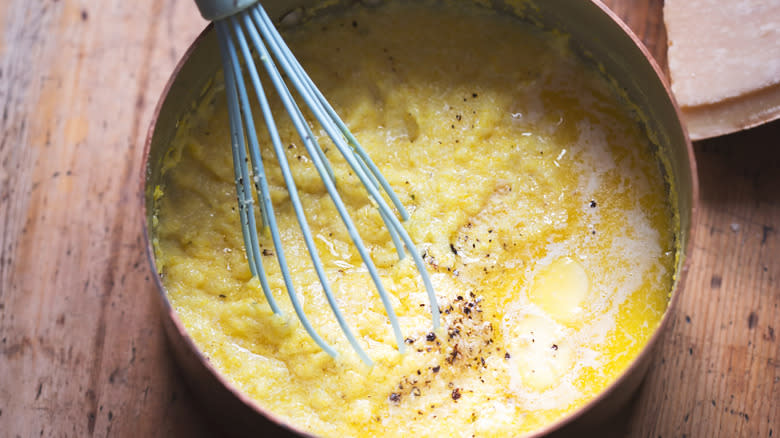For The Best Shrimp And Grits, Turn To The Stone-Ground Variety

Sit down to breakfast at any restaurant from Virginia down to Florida and you're bound to find grits somewhere on the menu. This humble ingredient is an absolute staple in Southern cuisine, prized for its versatility, cost, history, availability, and, of course, flavor. But grits can be puzzling to the unfamiliar, partially because the term "grits" refers to both an ingredient and a finished dish.
Grits the ingredient is a coarse variety of cornmeal made from a special type of corn known as dent corn, while grits the dish is essentially a cornmeal porridge similar to oatmeal, congee, or cream of wheat. When it comes to making them, there are a few different varieties from which to choose. Quick-cooking grits and instant grits are two of the more common options. These are heavily processed, with the latter being pre-cooked and dehydrated for ease of preparation.
And then there's stone-ground grits — also known as old-fashioned grits — which purists would say are the only type of grits worth making. These grits are coarser, less processed, and perishable (so store them in the freezer), but more importantly, they possess a hearty texture and deep corn flavor, making them the ideal base for a saucy plate of shrimp and grits.
Read more: 13 Tips To Make Your Shrimp Taste So Much Better
How To Accelerate The Cooking Of Your Stone-Ground Grits

There are multiple ways to prepare this delicious meal. That being said, some cooking methods will result in grits that are creamy while still retaining that pleasantly toothsome bite. Because they're coarser in the grind, stone-ground grits require a longer cooking time than the other varieties, but you can speed up the process with a little trick.
First, combine your grits and salted water in a large pot and bring it all to a rapid boil. Once boiling, shut the heat, cover with a lid, and allow the grits to soak and soften for around 10 minutes. You can take this time to prep any additional ingredients.
Finish the cooking by removing the lid and bringing the water back to a boil for between 15 to 25 minutes, stirring every so often so the grits don't stick to the bottom of the pot. After all the water has been absorbed, you should have a pot full of warm and fluffy grits. Now comes the fun part — stir in some butter, cheese, cream, herbs, spices, or all the above, and top with your spicy-smoky shrimp sauce mixture for the ultimate bowl of shrimp and grits.
Other Ways To Use Stone-Ground Grits

There's a lot you can do with stone-ground grits beyond serving them with shrimp. Grits are a blank canvas, a subtly flavored starch that can be served for breakfast, lunch, or dinner, so you can let your creativity run wild when deciding how to use them. For that first meal of the day, the simplest preparation is to top them with a poached egg, which allows that luscious yolk to blend seamlessly into the fluffy grits. Another fun idea is to use your leftover grits as the base layer of a quiche for a super-crunchy crust. Grits are also great when paired with a spicy tomato shakshuka.
When it comes to lunch and brunch, a cheese and sausage grit casserole will certainly satisfy your appetite and a table full of guests. And then there's the classic grit cake, which takes leftover grits and transforms them into a crisp slab that's a natural match for a rich Cajun étouffée. And for dinner, hone those fine-dining skills by topping your grits with an elegant braised lamb shank or perfectly grilled piece of fish.
To be honest, few foods taste better sitting on a bed of creamy, stone-ground grits.
Read the original article on Daily Meal.

